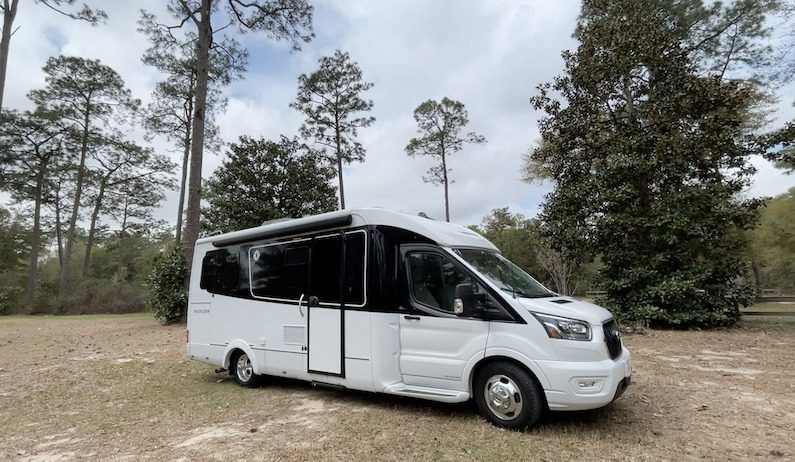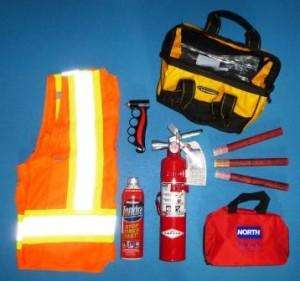How to Dewinterize Your RV or Camper for Spring

Spring is here and it's time to dewinterize your RV– Here's How!
If you're like me, you took great care to winterize your RV at the end of the last season.
But now it's that time of year to undo all that hard work. Even if it's been in winter storage, it's important to dewinterize an RV, travel trailer, or camper so that you can identify and fix any issues that may have occurred over the season.
I have written a few articles on winterizing, and even recorded a popular podcast on How to Winterize and Prepare for Cold Weather. I just realized I didn't have any helpful articles for dewinterizing… so here it is!
When Should You Dewinterize Your RV?
It is up to you when it's a good time to dewinterize your RV. However, it's a good idea to check the two-week forecast in your area to make sure you're really out of the cold season.
It is important to ensure temperatures are consistently reaching above freezing. Do not despair if a cold snap comes through after you have dewinterized your RV. Just be sure to keep the inside temperature of the RV warm, and holding tanks empty.
But, you definitely want to do it before the first trip of the season.
How to Dewinterize Your RV
Dewinterizing your RV does not have to be an overwhelming task. I have broken it down into three main sections to focus on: the exterior, the interior, and “other.” So, let's get to it! Here are my tips on how to dewinterize an RV.
1. Exterior of Your RV

When I dewinterize an RV, I like to work from the outside in. I start with the exterior and make my way to the inside. That way, I can stay consistent, completing each task to ensure that I don’t forget to do something.
Inspect the Exterior
The first step is to inspect your exterior. Visually inspect the outside of your rig for any cracks, water leaks, or water damage.
Look at the weatherstripping around doors and windows. If needed, replace any cracked or peeling sealant.
Be sure to inspect all roof, body, and slide-out seams. Apply any new seals if necessary.
Check Your Tires
Proper tire pressure can mean the difference between a smooth trip or “camping” on the side of the road.
While your RV is stored, its tires can lose about two to three psi of air pressure each month. Driving on underinflated tires can cause uneven wear and poor handling. Or worse, a blowout that can lead to a crash.
According to the National Highway Traffic Safety Administration (NHTSA), poor tire condition contributed to 655 vehicle crashes in 2017. Those tire-related crashes were the cause of 738 vehicle fatalities. That is why inspecting your tires is very important for driver safety.
To check your RV's tires, use a tire pressure gauge to check the psi in each tire, including the spare tire. In addition, look for signs of wear, like worn-down treads or cracks in the sidewalls. Replace any tires or add air with an air compressor as needed.
Motorhome Owners need to Check the Engine
The next step to dewinterize an RV is to check the engine for those of you who own motorhomes. Look at the fluid levels of each of the following:
- transmission
- power steering
- brake fluid
- engine oil
- engine coolant
- window washer fluid
Charge and Reinstall Your RV Batteries
Similar to your RV tires, your RV batteries may lose a percentage of their charge from internal leakage. Be sure to check and recharge them periodically while storing your RV. If you don’t, they will lose a small percentage of charge each month.
Check the charge on your batteries by using a voltmeter. Be sure that the RV is not connected to electricity, as that can lead to a false reading. If your 12-volt battery reads below 12 volts, it needs to be charged. Also, ensure that all battery connections are secure.
You also want to be sure that the battery fluid levels are within proper limits.
When reinstalling the RV battery, be sure that it is connected securely. If needed, you can contact an RV maintenance service to reinstall your battery.
Test Your RV Generator
Do you have an onboard generator? If so, check the oil level. If it's low, have a professional service it.
If the oil level looks good, check for any damage to the exhaust system. A damaged exhaust system can hurt the generator. If that is fine, you may start the generator.
If you exercised your generator while it was in storage, it should start up fine. If not, run it first for a few hours with only a half-rate load.
If the generator does not start pr is surging, have it looked at by a professional.
2. Interior of Your RV

After I finish with the exterior of my rig, I inspect and dewinterize the interior.
Flush Your Water System
When you travel, you rely on a clean water source for drinking, cooking, showering and washing dishes. Flushing your RV water system is crucial when you dewinterize an RV.
When you prepared your RV for winter, you most likely added non-toxic RV antifreeze to your system. That way, the pipes would not freeze. Now you’ll want to flush out the water system so that your water will be clean and safe to drink.
Sanitize Your Fresh Water System
The second important step to winterize an RV’s water system is to sanitize it. Even if you used non-toxic antifreeze to winterize your system you do not want to skip this step. It can help rid your system of any bacteria that can make you ill.
Check out our step-by-step guide to sanitizing your water system!
Check for Leaky Water Lines
To check for leaky water lines, ensure that there is water in the fresh water tank. Then turn on the electric pump to allow it to pressurize the water system. When the freshwater tank reaches full pressure, the pump should shut off.
Listen for a few minutes. If the pump turns back on or does not shut off at all, there is a leak somewhere in the system.
You can locate the leak by looking around water faucets, under sinks, and checking the plumbing system. Look around the toilet for leaking water around the edge.
Change Filters
Springtime is the perfect time to change out air and water filter cartridges. That way, you start camping season every year with all fresh filters!
It can keep your systems running efficiently and save money in the long run. Plus, a fresh air filter can help with allergies and asthma.
Check Windows and Air Vents
Open your RV’s air vents and windows to be sure they are in proper working order. Check the weatherstripping around each one. If any is damaged, replace it.
Safety Devices
Smoke alarms, carbon monoxide detectors, LP detectors, and fire extinguishers are important safety devices on board. You want to be sure they are working properly and up to date.
Check the expiration date on your fire extinguisher. If it is expired, purchase a new one.
Test your carbon monoxide and smoke alarms.
Windshield wipers can also crack in the cold, so be sure to test those, too.
Test 120-Volt Appliances
Plug in your rig and test all of the 120-volt appliances. Just be sure that you are using a 30- or 50-amp electricity source. That way, appliances like the microwave or air conditioner will run properly.
Check Propane System
Once the propane tanks are reinstalled, open the gas line and test each appliance. If testing the hot water tank, be sure that it is full of water first. It's also a good idea to do a quick check to ensure the water heater valves are in the right position.
3. Other Things to Check

You're almost done, but there are a few last items to check to dewinterize an RV.
Restock First Aid and Emergency Supplies
Check on the stock of your emergency supplies. Restock any that need it, and throw out any expired medications and dry food. Be sure to restock bottled water for emergency use.
Update Registration and Insurance
The spring is a great time to update your registration and insurance if needed. Completing this task once a year ensures that you are “road ready” for the season.
 Is Your RV in Storage More Often Than Not?
Is Your RV in Storage More Often Than Not?
If you are seriously interested in renting your RV, our new ebook, The Complete Guide to Renting Your RV will really help. (If you prefer to buy through Amazon Kindle or Apple Books go here.)
In this ebook, you will learn all the ins and outs of choosing which firms to list with (you can sign up with multiple rental companies!)
We help you navigate the confusing world of RV rental insurance and learn how to equip your RV, vet potential renters, handle emergencies and easily earn extra income with surprisingly little work.
We cover everything you should consider before you begin renting your RV. It includes some of the pros and cons of renting, talking about the risks and rewards involved.
Then it dives into the specifics of how much money you can expect to make renting out your RV, how to pick the best RV for you (if you don't already own one), and a great way to find/navigate an RV Rental insurance policy.


Totally agree with the statement even if it’s been in winter storage, it’s important to dewinterize an RV, travel trailer, or camper so that one can identify and fix any issues that may have occurred over the season. Dewinterizing is an important aspect that must be taken into the consideration. Enjoyed reading the article above, keep it up!